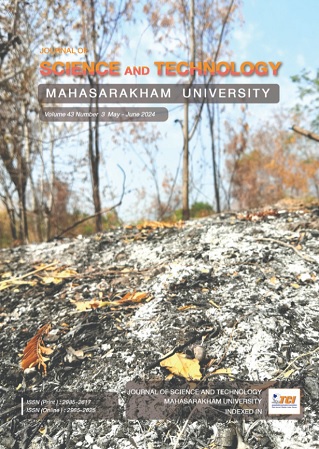The differences of sweat pore on fingerprints of Thai, Myanmar and Cambodian nationalities
Main Article Content
Abstract
Sweat pores are one of the features of fingerprints that can be used for identification. This research was conducted to study the data of sweat pore in Thai, Myanmar and Cambodian nationalities in 75 male volunteers aged 20-60 years. The selected areas were the thumbs of the right and left sampled by by rolling fingerprint method (from one edge of the nail to the other edge of the nail). Fingerprints were taken to study the sweat pores using the DCS4. It was found that the average sweat pore number was significantly different (p<0.05) across the three nationalities. The Burmese nationality had the highest average sweat pore number (115.12±2.25), followed by Cambodian nationality (107.12±1.60), while Thai nationality had the lowest average number of sweat pore (97.56±0.97). For the study of the position of sweat pore, it was shown that both closed and open sweat pores in all three nationalities were significantly different at p<0.05 and the closed type was more frequent than the open type. The large size of sweat pore did not differ between nationalities but small size and medium size were significantly different (p<0.05).
Article Details
References
สุนันทา ยาวาปี และรัชดาภรณ์ เบญจวัฒนานนท์. (2560). การศึกษารูเหงื่อบริเวณปลายนิ้วมือในลายนิ้วมือแฝงบนกระดาษชนิดต่างๆ ด้วย วิธีนินไฮดริน. วารสารวิทยาศาสตร์ มข., 45(3), 513-520.
สำนักงานตำรวจแห่งชาติ. (2561). คู่มือการปฏิบัติงานด้านนิติวิทยาศาสตร์ในการสืบสวนสอบสวน. กรุงเทพมหานคร.
สำนักงานพิสูจน์หลักฐานตำรวจ. (2559). คู่มือการปฏิบัติงานการตรวจพิสูจน์ลายนิ้วมือ ฝ่ามือและฝ่าเท้า. สำนักงานพิสูจน์หลักฐานตำรวจกรุงเทพมหานคร.
Ashbaugh, D.R. (1999). Quantitative-qualitative friction ridge analysis: An introduction to basic and advanced ridgeology (Series ed). CRC Press.
Bhagwat, V., Kumar, D.M. & Lakshmi, N.V. (2020). Poroscopy - the study of sweat pores among central Indian population. Scholars International Journal of Anatomy and Physiology, 3(6), 53-56.
Bindra, B., Jasuja, O.P. & Singla A.K. (2000). Poroscopy: A method of personal identification revisited. Anil Aggrawal’s Internet Journal of Forensic Medicine and Toxicology, 1(1).
Holder, E. H., Robinso, L. O. & Laub, J. H. (2004). The fingerprint sourcebook. Department of Justice Office of Justice Programs.
Jain, A. K., Chen, Y., & Demirkus, M. (2007). Pores and Ridges: High-Resolution fingerprint matching using level 3 features. IEEE Transactions on Pattern Analysis and Machine Intelligence, 29(1), 15-27.
Matltni, D., Maio, D., Jain, A. K. & Prabhakar S. (2009). Handbook of fingerprint recognition (2nd ed.). Springer-Verlag.
Oklevski, S., Jasuca, O.P. & Singh G. (2019). Poroscopy as a method for personal identification: Issues and challenges. Turkish Journal of Forensic Science and Crime Studies, 1(1), 36-49.
Preethi, D.S., Nithin, M.D., Manjunatha, B. & Balaraj B.M. (2012). Study of poroscopy among south Indian population. Journal of Forensic Sciences, 57(2), 449-452.
Tafazoli, M., Shahri, N.M., Ejtehadi, H., Haddad, F., Nooghabi, H.J., Shahri, M.M. & Naderi S. (2013). Biological variability of sweat gland pores in the fingerprints of a fars Iranian family from Khorasan Razavi province, Iran. Anatomical Sciences Journal, 10(2), 99-104.
Wijerathne, BTB. (2015). Poroscopy: an important research field in medicine and physical anthropology. Anuradhapura Medical Journal, 9(2), 44-46.
Zhao, Q., Zhang, D., Zhang, L. & Luo, N. (2010). Adaptive fingerprint pore modelling and extraction. Pattern Recognition, 43, 2833-2844.


